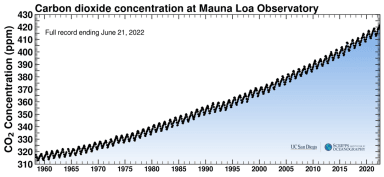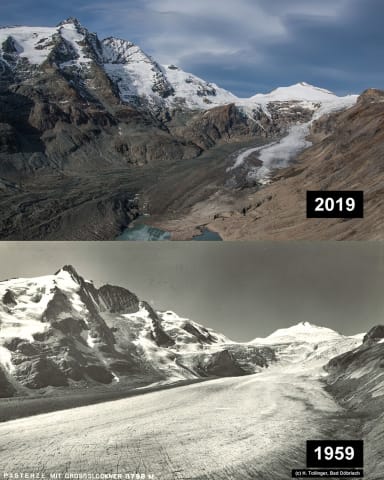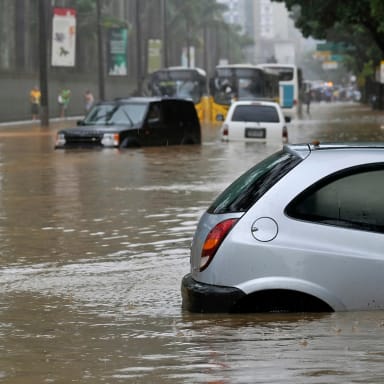What evidence is there for climate change?
Translated by Laura SteeghsClimate change is one of the most important issues of recent years. People are taking to the streets to demonstrate in favour of more climate protection. But climate change is not a new issue. Researchers have been collecting evidence of man-made climate change for decades. This blog post aims to give you a factual overview of the current state of research and summarise the most important evidence for climate change.
Why does man-made climate change exist?
There is a consensus in 99.9 per cent of all studies on the subject that man-made climate change exists. These studies consider the emission of greenhouse gases to be the main cause of the climate crisis. Greenhouse gases are, for example, carbon dioxide (CO2) and methane.
These greenhouse gases develop when oil, coal and gas are burned. Crude oil, coal and gas are chemically simple carbon compounds. This means that the burning of one kilogramme of coal, for example, produces 3.67 kg of CO2 (German). When this CO2 is released into the atmosphere, it does not simply disappear instantly. It remains there for decades or centuries.
The greenhouse gases prevent heat rays from the sun getting back into the atmosphere, which means this heat remains on Earth. This phenomenon is called the greenhouse effect and is considered proof of climate change. The greenhouse effect is currently celebrating its 200 year anniversary.
The mathematician and physicist Joseph Fourier said as early as 1824:
Thus the temperature rises by intervention of the atmosphere. Heat in the form of light enters the air unhindered - but is then prevented from returning after it has been converted into heat.
In theory, the more greenhouse gases we emit, the more our planet warms up. Greenhouse gas emissions are constantly increasing.
If the greenhouse effect is to be regarded as proof of climate change, we must now demonstrate that the climate is changing as a result of increased CO2 emissions.
How does the greenhouse effect prove man-made climate change?
First, let’s look at whether increased CO2 emissions really lead to more CO2 in the atmosphere. After all, it is possible that the CO2 quickly dissipates again.

The fact is that the concentration of CO2 in the atmosphere is constantly rising. Our air contains more and more CO2. In 2022, there were 40 billion tonnes of CO2 in the atmosphere. And this figure only refers to CO2. Other greenhouse gases such as methane are not taken into account. From this we can conclude that CO2 is indeed in the atmosphere.
Now, in order for this to be considered proof for climate change, we must first prove that there is a direct link between more CO2 in the air and a rise in temperature on Earth.
What evidence is there for climate change?
Proof of man-made climate change: the rise in temperature
The more CO2 humankind emits, the higher our temperatures become.
Research has now shown there is a link between the concentration of CO2 in the atmosphere and rising temperatures on Earth.
Some sources report that we are already experiencing global warming of over 1.5 degrees Celsius above pre-industrial levels.
These 1.5 degrees are important because a permanent temperature rise of 1.5 degrees has serious consequences for all life on Earth.
However, the rise in temperature is not the only evidence of the climate crisis.
Proof of man-made climate change: the melting of glaciers

The Earth’s glaciers are melting. This is often cited as proof of climate change.
As can clearly be seen in the photo on the left, the glaciers are melting. But is this actually proof of climate change?
Yes. While some local weather phenomena also influence the melting of glaciers, the main culprit is the change in the Earth’s temperature.
As the glaciers melt, the sea level rises, which brings us to the next piece of evidence for climate change.
Proof of man-made climate change: sea level rise

Naturally, higher temperatures on Earth are also causing the polar ice caps and other ice sheets to melt. This causes fresh water to enter the oceans leading to rising sea levels.
Water is densest at 4 degrees Celsius, which means it takes up the least space at this temperature. When you heat the water, it expands. Water with a temperature of 20 degrees takes up more space than water that is only 10 degrees. So the warmer the water in the oceans, the more space it needs.
The IPCC report states that with average greenhouse gas emissions, sea levels will rise by 0.44 - 0.76 metres by 2100. You can read more about sea level rise on our blog.
Proof of man-made climate change: extreme weather events
It seems easier to link the climate crisis to droughts and heatwaves. In the future, there will simply be more hot days and fewer cold ones.
This is because the average temperature is shifting to the right in the graph. There will be more hot and extremely hot days but fewer colder days. You can find out more about extreme weather and the climate crisis on our blog.
But it’s not just heat waves that will increase, heavy rain and thunderstorms will too.
Climate change is also responsible for heavier rain showers. The warmer the air, the more water it can store. For every additional degree, the air can absorb 7% more water droplets - more water that can then pour down heavily elsewhere.
We also have to be prepared for more severe thunderstorms. Scientists have proven that the frequency of lightning in the Alps, for example, has almost doubled in the last 40 years. Higher temperatures and more water in the atmosphere lead to more thunderstorms.
To summarise: In the 21st century, the frequency of extreme weather events is increasing significantly in Europe due to climate change. While only double-digit numbers of extreme weather events were measured at the beginning of the 20th century, this figure rose to 1,452 extreme weather events in 2019.
Let’s take a look at counter-evidence to climate change
But isn’t the greenhouse effect good for Earth?
Yes, the natural greenhouse effect is good for our planet. Without it, human life would not be possible. Also CO2 is important. Without CO2, plants could not exist.
The problem, however, is the mass emission of CO2 in an incredibly short period of time. Of course, Earth will recover from this after a very long time. After all, the CO2 that we emit will be degraded again in many hundreds of years.
For us humans, however, the climate crisis is now becoming an immediate concern. If we miss the 1.5-degree target, it will have irreversible consequences for all life on Earth.
Our goal should be to take smart steps now to protect life for present and future generations. At present we have the opportunity to act in an economically, ecologically and socially sustainable way to build a climate-friendly future.
Hasn’t the climate always been changing?
Yes, it has always fluctuated - even before humans existed. But the high level of CO2 emissions caused by humans is unprecedented in the history of Earth. Specifically, humankind has released enormous amounts of sequestered CO2 into the atmosphere in a very short space of time by burning coal, gases and fuels. Of course this is changing our climate.
But doesn’t it still snow sometimes?
Climate is not the same as weather. We use weather to describe whether it is raining today or tomorrow, how warm it is or if it is snowing. Climate refers to weather phenomena over a very long period of time. We often compare decades or even centuries.
Climatic changes are gradual, but they happen. And once they have occurred, we can’t turn back time (German).
Summary of the evidence for climate change
We all wish climate change didn’t exist. But it does. Every day we emit huge amounts of CO2 into the atmosphere and warm the Earth’s climate.
Science has shown in several ways that climate change is here and it will present us with completely new challenges.
At the same time, we now have a great opportunity: if we manage to solve the climate crisis, we will emerge stronger.
More CO2-friendly products and services, renewable energies and a healthy environment can be our focus. We now have the chance to pave the way to a climate-friendly future.
Every tenth of a degree makes a difference.